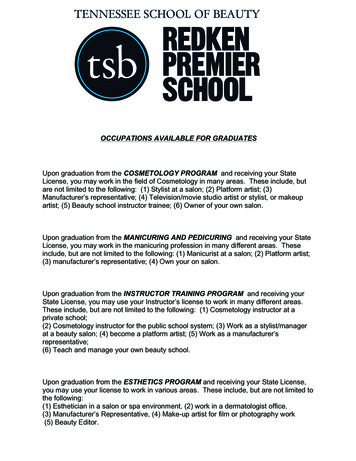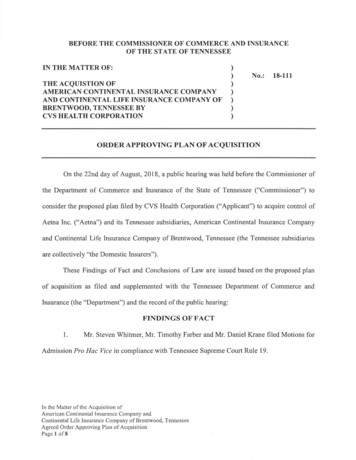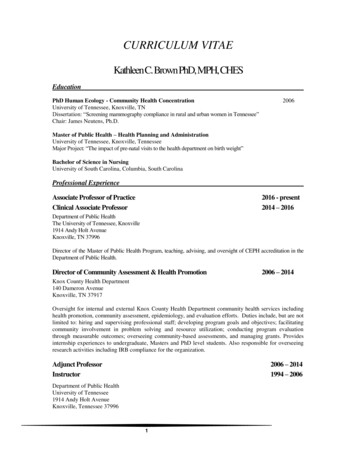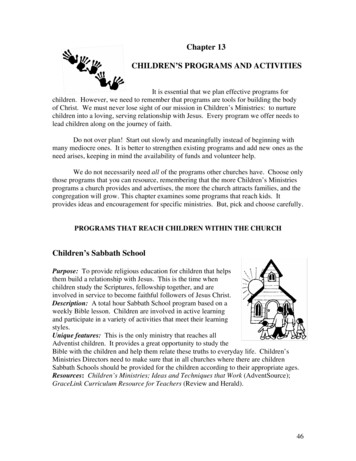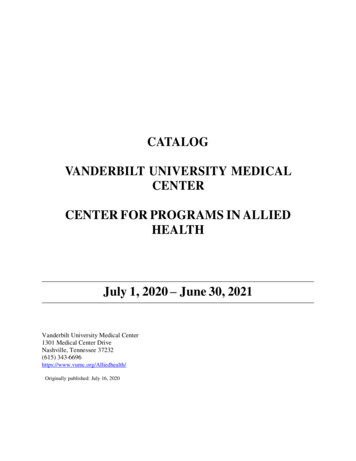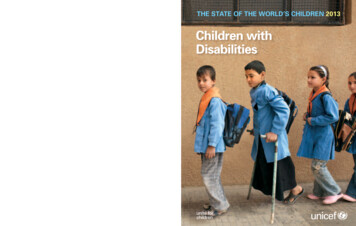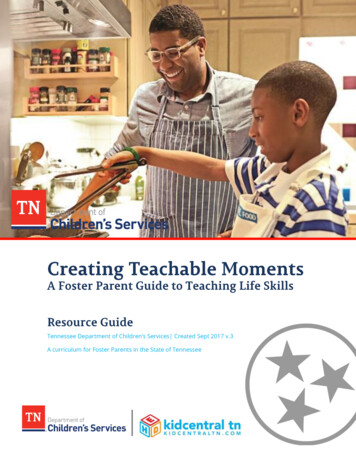
Transcription
Tennessee Department of Children’s Services Created Sept 2017 v.3A curriculum for Foster Parents in the State of Tennessee
Ready, Set, Fly!A Parent’s Guide To Teaching Life SkillsTucson Division1600 North Country Club RoadTucson, AZ 85716-3160www.casey.org 2001. Casey Family Programs. Seattle WA. All rights reserved.
Program OverviewCasey Family ProgramsFoundations for the FutureThe mission of Casey Family Programs is to support families, youth, and children in reaching their full potential.Casey provides an array of permanency planning, prevention, and transition services such as long-term family fostercare, adoption, kinship care, job training, and scholarships. Through advocacy efforts, national and local communitypartnerships, and by serving as a center for information and learning about children in need of permanent familyconnections, the Programs aim to improve public and private services for children, youth, and families affected bythe child welfare system.Casey Family Programs is a Seattle-based private operating foundation, established by JimCasey, founder of United Parcel Service (UPS), in 1966. The program has 29 offices in 14 statesand Washington, D.C. For more information, visit our web site at www.casey.org.Board of TrusteesRichard D. Ford, PresidentJoan B. Poliak, Vice PresidentDuncan A. Bayne, SecretaryRichard E. Bangert, TreasurerPatricia Batiste-Brown, TrusteeGary Severson, TrusteeJohn C. Peterson, MD, TrusteeEarl L. Buckley, Trustee EmeritusGeorge E. Fahey, Trustee EmeritusJohn N. Riese, Esquire, Trustee EmeritusChief Executive OfficerRuth W. MassingaExecutive Vice President of Strategyand Program DevelopmentJean McIntoshExecutive Vice President of RegionalOperationsJames MarquartAcknowledgementsReady, Set, Fly! was developed through the efforts of many dedicated child and family servicestaff members, foster parents, and youth. The Tucson division’s Self-Sufficiency team dreamedof this project, championing it to fruition. They include Susan Bergesen, Sharon Dobbin,Maureen Andrew and Gloria Verdin. In addition, Ami Nagle, an independent contractor with theTucson division was instrumental in conducting the focus groups and writing the activities.Josette Kehl, an independent contractor, was the project coordinator and assisted with writingand editing, and Melissa Sabol and T. Kay Estes, social work interns, provided clerical support.Research Services also supported this endeavor by transcribing focus group tapes, generalediting assistance and coordinating the print and online design work. They include Kimberly A.Nollan, Margaret Jeffrey, A. Chris Downs, and Richard Bressani. We also thank Dorothy Anselland Joan Morse for their feedback on the activities and the focus group process.We gratefully acknowledge the assistance of the following dedicated foster parents and youthwho faithfully attended at least one focus group, sharing their knowledge and ideas about how toprepare youth for living on their own. They include: Angela Adkins, Patti Adkins-Tutty, RonAlegria, Dawn Alegria, Marie Cephers, Ray Christian, Shirley Christian, Melissa Croft,
Melanie DiCicco, Alex Enoch, Pat Espinosa, Albert Garcia, Gloria Garcia, Mary E. Stafford,Beth Harper, Pam Ketterling, Mary Killary, Eileen Loughrey, Jeffrey Macbeth, BarbaraMartinez, Carlos Martinez, Mildred A. McClain, David McDonald, Lillie Murray, EvangelinaNavarrette, N. Lejana Olague, Juanita Pennington, Jesus E. Perez, Charlotte Perez, BarbaraReyes, James O. Reyes, Pearl Taylor, Reggie Taylor, Vivica Taylor, Lucia Tempe, WilliamThomas, Robert Villelas, Terry Villelas, and Carol Zuckert.We also acknowledge Tucson Division staff members who provided valuable ideas and supportfor this project. They include Susan Abagnale, Ana Acuna, Leslie Butler, Jorge Cabrera, AmyCox, Dixie Ellis, Levonne Gaddy, Joan Hansman, Fredericka Hunter, Cindy Johnson, MarjorieParks, Yvonne Rodriguez, Rosalyn Riesgo, Leora Sanders, Laura Stockert, Ward Townsend,Beth Treas, Bobbie McNeill, Bea Kea, and Patricia King.Table of Contents1. Introduction2. How to Use3. Daily Living Skills4. Housing, Transportation & Community Resources5. Money Management6. Self-Care7. Social Development8. Work & Study Skills9. Ms. Quince Años: A Story of Life Skills in ActionReady, Set, Fly! A Parent’s Guide To Teaching Life Skills 2001 Casey Family Programs.
1. IntroductionReady, Set, Fly! A Parent’s Guide to Teaching Life Skills was created through a series ofdiscussion groups with foster and adoptive parents, teens, and young adults at the TucsonDivision of Casey Family Programs. The goal was to develop a practical resource to helpcaregivers teach youth some of the skills that are needed to enable youth to live successfully ontheir own. The skill areas described in the Life Skills Guidebook (www.caseylifeskills.org) wereused to guide discussions and form the foundation of this activity book. Ready, Set, Fly! is acompanion tool for the Life Skills Guidebook (Guidebook) and contains activities for use in oneon-one settings. It was created primarily with foster parents in mind. However, the activities areuseful for all parents as they teach life skills to children and youth. Child welfare professionalsmay use this book to provide suggestions to caregivers about teaching life skills to their children.The activities are age appropriate and developmental, matching the levels of the Ansell-CaseyLife Skills Assessment (www.caseylifeskills.org) and Guidebook (ages 8-10, 11-14, 15-18, and19 and older).DescriptionThe Tucson division created Ready, Set, Fly! for several reasons. First, staff needed a resourcethat would help them work more easily with families and youth to teach life skills. While parentshad resources that described what skills youth should be building, they lacked concrete activitieswhich would help them teach these skills in their own homes. Second, the Tucson staff alsowanted a guide to help parents become aware of the “teachable moments” in everyday life thatprovide opportunities for teaching skills. To meet these needs, a fun, user-friendly instructionbook containing developmentally arranged activities was created.To create Ready, Set, Fly!, foster and adoptive parents met in discussion groups to discuss the sixlife skill areas in the Life Skills Guidebook (daily living skills, housing, transportation andcommunity resources, money management, self-care, social development, and work and studyskills). During the discussion groups, creative and effective ideas of how parents taught andyouth learned life skills in one-on-one situations were brainstormed. These ideas were thenReady, Set, Fly! A Parent’s Guide To Teaching Life Skills 2001 Casey Family Programs.
organized into an easy-to-use format for other parents to use in teaching life skills. Theseactivities vary from simple to more complex and can be used with children whose ages rangefrom elementary to post high school.2. How to Use Ready, Set, Fly!The activities in this book are organized into six areas, or domains, that match the sections of theAnsell-Casey Life Skills Assessment (ACLSA) and Life Skills Guidebook. Parents and youthcan easily select the level of each activity, according to the youth’s age, that will be most helpfulto the youth’s life skill growth. The difficulty of each activity is rated using the following scale:Level 1 is for youth ages 8-10 yearsLevel 2 is for youth ages 11-14 yearsLevel 3 is for youth ages 15-18 yearsLevel 4 is for youth ages 19 and olderReady, Set, Fly! may be used as a resource guide by itself or in conjunction with the Life SkillsGuidebook and ACLSA. As a guide for parents and/or child welfare professionals, Ready, Set,Fly! offers many suggestions for creative life skills activities to help youth reach their life skillgoals. Often just reading about these activities will give parents ideas to create their ownactivities, which may better fit their child’s needs.What is a Teachable Moment?In the course of daily life, opportunities appear to guide a youth’s life skill development.Often these occur when the youth wants, needs, or shows interest in something. The parent theninvites the youth to engage in learning. Parents may also “create” these moments. The key forparents is to develop awareness of teachable moments and use them!Ready, Set, Fly! A Parent’s Guide To Teaching Life Skills 2001 Casey Family Programs.
Using Ready, Set, Fly! with the ACLSA and Life Skills GuidebookFor those parents or caregivers interested in assessing what life skills youth already have andareas where they may need to grow, we recommend using the free, Internet-based Ansell-CaseyLife Skills Assessment (ACLSA) (www.caseylifeskills.org). Once the ACLSA is completed byeither a youth or caregiver, an individual report summarizing the assessment results isimmediately sent to the person’s e-mail address.Using the ACLSA summary, the parent and youth can determine in what areas the youth needsto expand his/her skills. Next they can consult the Life Skills Guidebook via the Internet, inorder to look at the competencies (skills) recommended for youth to learn in a particular skillarea. For example, if the ACLSA reveals that a youth lacks skill in the area of moneymanagement, the Guidebook section on money management will offer a variety of moneymanagement competencies that the youth may learn in order to increase mastery of thisimportant area. Parents or caregivers are encouraged to help youth set goals to learn these skillson a gradual basis.After reviewing the ACLSA results and consulting the Guidebook regarding life skillcompetencies, parents may need some ideas about activities to use in helping youth develop lifeskills. Each life skill competency within the Guidebook contains suggested activities forteaching that skill. Ready, Set, Fly! is one of the resources for activities used in the Guidebook.These activities can be easily modified to fit a particular family’s lifestyle or approach toteaching life skills. Once the youth has begun learning new life skills, the ACLSA can be takenagain. This will show the youth’s progress in different areas.For Foster Parents and Child Welfare ProfessionalsFoster parents, caseworkers, and other professionals working with youth in out of home caremay use Ready, Set, Fly! by following the procedures described in the section above. Inaddition to using the ACLSA report, Life Skills Guidebook, and Ready, Set, Fly! to help youthReady, Set, Fly! A Parent’s Guide To Teaching Life Skills 2001 Casey Family Programs.
learn skills, individual or group learning sessions may also created. This is done by consultingthe Life Skills Guidebook which contains suggested activities (including references to Ready,Set, Fly! activities) for teaching each life skill competency to youth. Caseworkers, youth orcaregivers can simply select competencies and activities from the online Guidebook and create acustomized Life Skills Learning Session template. This template can be printed out or copiedinto your favorite word program. With minor editing, a plan for life skills instruction is createdfor use with individuals or groups and can be saved for future reference.Once the youth has started working on the plan, the ACLSA can be given again. This will showthe youth’s progress in different areas. For group settings, all members of a Life Skills groupcould take the ACLSA before and after the group; changes in scores will show how effective thegroup has been.The next six sections provide comprehensive, developmental activities in the areas of daily livingtasks, housing & community resources, money management, self- care, social development, andwork & study skills.Ready, Set, Fly! A Parent’s Guide To Teaching Life Skills 2001 Casey Family Programs.
3. Daily Living SkillsThere are many things our children need to learn in order for their lives (and ours!) to runsmoothly. Learning daily living skills - including meal planning, grocery shopping, cooking,dining etiquette, laundry, and home safety - are important to make sure that your children knowhow a home functions, how to contribute to maintaining a household, and one day be able to runtheir own home.Nutrition1. Food PyramidFind out from your child's school in what grades he/she will learn about the food pyramid.Help children have fun during family meals by talking about where each of the foods they areeating fit into the food pyramid. Levels: 1 22. Variety For NutritionOver dinner, talk with your child about different parts of the meal and why they areimportant (meat/poultry/beans provide protein, vegetables provide vitamins and minerals,starches provide carbohydrates for energy, dairy foods make our bones strong).Levels: 1 23. Evaluating A Fast-Food MealWhen eating at a fast-food restaurant, ask your youth to guess the nutritional value of themeal and to name the healthiest parts of the meal. If the restaurant provides nutritionalinformation, look up what you're eating and talk about fat, calories, protein, etc.Levels: 1 24. Planting A GardenHave your youth help you plant and tend a vegetable garden. The youth can learn abouthealthy vegetables and have the fun of eating them! Levels: 1 2 35. Healthy SnacksWhen grocery shopping with your youth, have them choose a variety of healthy snack foods.Talk about what makes a snack healthy. Also, invite youth to make some healthy snacks(celery sticks with peanut butter, tortillas, popcorn, sliced apples). Levels: 1 2 3Ready, Set, Fly! A Parent’s Guide To Teaching Life Skills 2001 Casey Family Programs.
Menu PlanningTip: Remember The Green Things!!When grocery shopping, encourage children to pick out the "green things"that you will eat with your meal that week.1. Making A Favorite Recipe CookbookCreate a "best recipes cookbook." After making a meal, have the youth determine whether ornot to include it in their very own "cookbook" (notebook, binder, card file box). Level: 2Older youth can be in charge of their own recipe book, and can write down several weeks ofmenus for when they move out on their own. Levels: 3 42. Meal PlanningMake a list of "main dishes" for a week of evening meals (lasagna, enchiladas, barbecuedchicken). Have your youth make suggestions for what side dishes (vegetables, fruit, starches)would ge well with each one. Levels: 1 23. Putting It All TogetherLet older youth plan the family menu for a week. Encourage them to include a main dish,vegetable and starch for each meal and a dessert for a few of the meals. Levels: 2 3 4Grocery Shopping1. Keeping A Shopping ListKeep a shopping list on the side of the refrigerator. Ask your child to write down items thatthey use the last of (like milk) or any other items your family needs. Level: 12. Developing A Shopping ListAsk an older youth to make out the family shopping list for a whole week. Make sure he/sheincludes the ingredients for the meals they have planned as well as items like paper goodsand cleaning products. Levels: 2 3 4 To give the youth an idea of the cost of the items, invitethem along to help you shop and ask them to keep track of the cost by using a calculator.Levels: 2 3 43. Meal Planning, To Shopping List, To BuyingCreate a shopping list with your child for a special event like his/her birthday orThanksgiving. For younger children, ask what they would like to eat at the meal and haveReady, Set, Fly! A Parent’s Guide To Teaching Life Skills 2001 Casey Family Programs.
them write that on the list. Level: 1 For older youth, ask them to identify the ingredients forthe meal and add these to the list. Level: 2 Older youth can be given a set amount of moneyfor the ingredients and allowed to shop on their own. Levels: 3 44. Grocery Shopping PracticeWhen you are at the store, have your child be responsible for finding certain items on theshopping list. Levels: 1 25. Thrifty ShoppingGive your child your weekly shopping list and the coupon section of the newspaper. Askthem to find as many coupons as they can for items on your list. To really motivate them,offer to give them the money saved by using coupons (many stores show this amount at thebottom of the receipt). Levels: 1 2 36. Comparison Shopping In The SupermarketWhen you go to the store, have the youth find the items on your list, compare brands, anddetermine which is the most economical. Teach your child to read unit pricing labels onproducts (if the store has these). Talk about the quality vs. cost of a product. The leastexpensive one is not always the best one to buy. Levels: 2 37. More Comparison ShoppingWhen looking for a specific product, review store ads. Show how two stores with the sameproduct have different prices. Discuss the pros and cons of going to multiple stores in aneffort to get the best prices on all the products. Do a "supermarket survey" by shopping attwo or more stores for the same items to see which store has the lower prices. Levels: 1 2 38. Choosing Good ProduceWhen at the grocery store, show your children how you can tell if a fruit or vegetable isfresh. Ask the produce manager for tips, if you're not sure. Level: 1 Have older youth beresponsible for picking out the fruits and vegetables on your list. Levels: 2 39. Shopping AlonePull together everything an older youth has learned about meal planning and shopping byletting them plan a week's worth of meals, develop the shopping list, and then purchaseeverything with a set amount of money. Levels: 3 4Ready, Set, Fly! A Parent’s Guide To Teaching Life Skills 2001 Casey Family Programs.
Meal Preparation1. Hands-On PracticeTo get your children involved in cooking, start by having them help prepare one item. Forexample, younger ones could help prepare the salad or grate cheese. Level: 1 Older youthcan help with more difficult items like rice, pasta, tortillas or browning meat, etc.Levels: 2 32. Practice With RecipesAlthough we don't use recipes every time we cook, it is good to know how. When your childwould like to fix something special, have them choose a recipe from a cookbook. You cansupervise them reading and following the recipe. Levels: 1 2 Older youth can beunsupervised and all can enjoy their creations. Level: 33. Cooking Without A RecipeHave your child join you in the kitchen when you make a traditional family dish that doesn'tuse a recipe. Explain to them what ingredients you are using and how you are preparing thedish. If they want to learn how to make it, have them write down what you tell them so theycan keep it in their Best Recipes Cookbook. Levels: 1 2 34.Foods From Around the WorldHave your youth help you choose and prepare a meal from a different cultural background.Talk about the different elements, spices, eating utensils, etc. Levels: 2 35. Show What You've LearnedAsk your youth to help you prepare dinner once a week. Let them read recipes (if used) andparticipate in the actual cooking. Later on, let them prepare a favorite meal by themselves.Levels: 2 3 When ready, have them prepare family dinners for one week. Levels: 3 4Teachable MomentWhenever you're in the kitchen cooking and your children come in to seewhat smells so good, ask them to help you stir, mix, taste, measure, or help insome way. Use their natural interest to build skills!Dining Etiquette1. Setting The TableHave your youth take turns setting the table for dinner. Level: 1 If you have a formal dinner,show youth how to set the table for this (use china/special dishes if you have them), then letthem try setting the table by themselves. Level: 22. International EtiquettePlan a potluck meal with friends from a cultural background different than your own. HaveReady, Set, Fly! A Parent’s Guide To Teaching Life Skills 2001 Casey Family Programs.
youth ask the guests about the utensils, manners, food, and dining customs that are a part oftheir culture. Levels: 1 2 3 4TipTell youth that they can always watch what others at their tables are doing ifthey don't know which fork to use at a fancy dinner!3. Formal DiningHave a "dress up" night where youth have the opportunity to practice using all the utensilsthey would see at a fancy restaurant. Explain the placement of different utensils and how touse them. Levels: 2 34. Dining OutWhen eating at a restaurant, encourage your youth to order for themselves, help you calculatethe tip, and check the bill for accuracy. Levels: 2 3 45. Using Good MannersOffer a prize to the child who is able to use good manners and talk about appropriate thingsat the table or in a restaurant. Talk beforehand about what good manners are. Levels: 1 2Kitchen Clean-Up and Food Storage1. Putting Food AwayAfter the meal is finished, have each child be responsible for putting away one leftover item.If children take lunch to school, ask if they want to take any leftovers. If they are given lunchmoney, let them keep the money they don't spend by eating leftovers. Levels: 1 2Teachable MomentWhen you clean out the refrigerator, have your children join you. They can"scientifically" examine food in the refrigerator and use their senses to see iffood has gone bad. They can read the expiration dates, look at the food, smellthe food, and then taste the food (unless it's unsafe).2. Cleaning Up After MealsHave your family take turns cleaning up after a meal. Younger children can help to clear thetable. Level: 1 Older youth can wash and dry dishes, fill the dishwasher, and clean thestove/counters, sweep, etc. Levels: 2 3 Older youth can independently clean the entirekitchen at least once weekly, which could be tied to an increased allowance. Levels: 3 4Ready, Set, Fly! A Parent’s Guide To Teaching Life Skills 2001 Casey Family Programs.
3. An Experiment In Food StorageDo an experiment! Place a small amount of raw food and cooked food in the refrigerator.Have youth guess which will spoil first. After about a week, check your experiment. Levels:1 2 Talk with youth about how soon food items should be eaten, or if anything can befrozen to make it last longer. Levels: 1 2 3TipPut on the youth's favorite music to motivate them during kitchen clean up.Home Cleaning and Clothing Care1. Motivation For CleaningWhen encouraging your children in household cleaning, make a game of who can do the taskfastest and most accurately. Tell them you will hold an official "inspection" of their work at acertain time (if done incorrectly, they must go back and do it over again). Celebrate wheneveryone finishes their work! Levels: 1 22. Chore ChartsDevelop a chore chart. Have your child help you think of all the chores that need to be donearound the house each week or once a month. After chores are done well and finished, theycan be checked off the chart. You may even want to link allowance or special privilege todoing chores. Levels: 1 2 33. Why Clean?When developing a list of chores, ask youth about reasons for keeping a house clean (youcan find things, it's organized, it takes less time to keep a house clean than to let it get reallymessy and then have to clean it). Levels: 1 24. The Right Tool And Supplies For The JobWith supervision, encourage your youth to experiment with using sponges, scrubbers, rags,etc. to clean. Let them try various cleaning supplies to see what product works best. Teachthem in steps. First, demonstrate how to use the item, then let the youth try it with your help.Finally, supervise them while they do the work on their own. Levels: 1 2 35. Cutting Down On ClutterUse a family "catch-all basket." Keep a basket in a convenient spot. If your child seessomething lying around and is not sure where it goes, it should be put in the basket. At theend of the day have everyone help put the basket items away. This helps teach familymembers where things go and helps the house stay tidy. Levels: 1 2 3Ready, Set, Fly! A Parent’s Guide To Teaching Life Skills 2001 Casey Family Programs.
6. Cleaning Out ClosetsHave youth help you clean out a closet or dresser. Identify which items should be thrownaway and which could be given away to charity or taken to a re-sale store. Levels: 1 2 37. Sorting And WashingHave youth wash a piece of colored clothing with an old towel or sheet, and then describewhat happens. Talk about or show the importance of separating light and dark clothingbefore washing. Levels: 1 28. Beginning To Do LaundryGive your child his/her own laundry basket. Have children help you do laundry by measuringthe soap and putting it into the washer. Have them fold small items like dishtowels and washcloths, and eventually their own clothing. They can have fun matching their socks andthrowing them into the basket! Levels: 1 2TipOne way to motivate kids to help with the laundry is to let them keep anychange they find in the washer or dryer.9. More Practice Doing LaundryIntroduce your youth to the idea of doing laundry by showing them the different settings, andthen letting them wash a load of clothing on their own. Levels: 2 310. Using A LaundromatTake your youth to a laundromat to do a load of wash. Show them how to use the machinesand let them wash a load of clothes on their own. Levels: 2 3Home Safety and Repairs1. Maintaining Smoke DetectorsTo explain the importance of fire prevention, have your children help replace batteries insmoke detectors. Level: 1 With older youth, have them be responsible for replacing batterieson a regular schedule. Levels: 2 32. Fire SafetyTo teach children about fire safety, hold mock fire drills. Draw a house plan and decide thebest way to get out from each room in the house. Decide where to meet once everyone is outof the house (a neighbor's house, in front of a particular tree). Levels: 1 2 3Ready, Set, Fly! A Parent’s Guide To Teaching Life Skills 2001 Casey Family Programs.
3. First Aid/CPRUsing the child's dolls, teach basic first aid. Level: 1 When they are older, youth can go tofirst aid and CPR classes. Levels: 2 34. Emergency KitsHave your children help pack an emergency kit for the car and one for the home. Discusswhat to include in each (e.g., flares, flashlight, first aid kit). Levels: 1 25. Using ToolsShow younger children how to use tools by starting with toy tools. Level: 1 If a pictureneeds to be hung, have your children help you decide where to hang the picture, measure tomake sure it is even, and hammer a nail into place. Have them watch, then assist with simplehome repairs like replacing a light bulb, plunging a toilet, etc. Levels: 2 36. The Importance Of InsuranceHave your youth help you complete a "home inventory." Use a pen and paper, a camera, or avideo camera to record the items in each room of your house. Use the opportunity to talkabout the value of homeowner's or renter's insurance to help you replace these things if theyare lost, stolen, or destroyed. Levels: 3 4Ready, Set, Fly! A Parent’s Guide To Teaching Life Skills 2001 Casey Family Programs.
4. Housing, Transportation, and Community ResourcesHousing and transportation costs are some of the largest items in our family budgets. Helping ourchildren to learn about the importance of and costs associated with housing and transportationhelps them to make successful transitions to adulthood and independence. Knowing aboutcommunity resources helps children and youth realize the support and information available tothem, as well as the responsibility of being a good community member.Housing1. The Housing GamePlay the alphabet game with young children. Have the child think of a place you can live foreach letter of the alphabet ("A" is for apartment, "B" is for boat, etc.). Levels: 12. What You Need In A Living RoomEach of us has different housing requirements. Have the youth make a list of all of the kindsof items that would be important for their living arrangement (close to bus line, twobedrooms, furnished or unfurnished, pets allowed, etc.). Levels: 2 3Tip"We often encounter people who live in different living arrangements. Wecan use that as an opportunity to talk about the various housing options outthere. Not everybody is a homeowner, not everybody is a renter. Somepeople live with relatives, some board in a house, some live in a hogan.There is no one "right" kind of housing." - Foster Parent3. Having a RoommateHaving roommates can be a great opportunity and/or a bad decision. Have the youth list prosand cons of having a roommate, living with a relative, or boyfriend/girlfriend. Help the youthmake a list of questions to ask a potential roommate. Levels: 2 3 44. What Kind Of Roommate Would They Be?When watching a favorite TV show - whether it is "Sesame Street", a cartoon, or "Friends" ask your child or older youth to identify what kind of roommate each character would make.Levels: 1 2 3Ready, Set, Fly! A Parent’s Guide To Teaching Life Skills 2001 Casey Family Programs.
5. Housing ExpensesA major aspect of stable housing is being able to afford all the costs of housing. With youngchildren, have them help as you pay for housing bills-rent/mortgage, utilities, etc. As theylick envelopes or put on stamps, talk about what you are paying for. Level: 1 Have olderyouths create a list of housing expenses like utilities, furnishings, kitchen supplies, linens,and paper goods, and identify how much each item will cost. Levels: 2 36. The Cost Of RentingPick out an advertisement for an apartment rental from a newspaper or housing guide. Talkabout the terms and costs mentioned in the ad (security deposit, utilities, first month free) aswell as costs not mentioned in the ad (application fee, furnished vs. unfurnished costs, petdeposit, etc.) Levels: 3 47. Having A Back-Up PlanThere is a strong link between employment and stable housing. When reviewing a samplehousing budget, ask the youth to describe how they would pay for their housing if they werelaid off, fired or quit their job. Use the opportunity to talk about the importance of having asavings "cushion"-money saved up just for emergencies. Levels: 3 48. Finding HousingThere are many ways to find housing. Share the story of how you fou
Ansell-Casey Life Skills Assessment (ACLSA) and Life Skills Guidebook. Parents and youth can easily select the level of each activity, according to the youth’s age, that will be most helpful to the youth’s life skill growth. The difficulty of each activity is rated using

